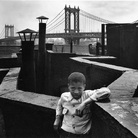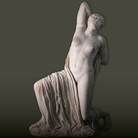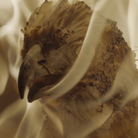Hiroshi Sugimoto. Modern Times

Hiroshi Sugimoto, Einstein Tower, 2000. Gelatin silver print, cm 149x119.5
Dal 5 June 2014 al 12 October 2014
Venezia
Luogo: Fondazione Bevilacqua La Masa - Palazzetto Tito
Indirizzo: Dorsoduro 2826
Orari: da mercoledì a domenica 10.30-17.30
Curatori: Filippo Maggia
Enti promotori:
- Japan Foundation
Costo del biglietto: intero 5 €, ridotto 3 €
Telefono per informazioni: +39 041 5207797 / 02 624991
E-Mail info: press@bevilacqualamasa.it
Sito ufficiale: http://www.bevilacqualamasa.it
Inaugura il 5 giugno alla Fondazione Bevilacqua La Masa di Venezia la nuova personale di Hiroshi Sugimoto (1948, Tokyo, Giappone). Allestita negli spazi di Palazzetto Tito e curata da Filippo Maggia, la mostra presenterà in anteprima mondiale le nuove produzioni dell’artista giapponese, realizzate in occasione della XIV Biennale d’Architettura, e dedicate alle icone dell'architettura internazionale. La prima esposizione italiana permette di ammirare in via esclusiva undici fotografie che l'artista ha realizzato all'interno dei più famosi musei internazionali e celebri monumenti.
In mostra nelle sei sale di palazzetto Tito le vedute del Johnson Wax Building di Frank Lloyd Wright, la Torre Einstein di Erich Mendelsohn e il monumento ai Caduti del futurista Antonio Sant’Elia sono affiancate dall’ultimo inedito lavoro dedicato a due dei più importanti luoghi dell’arte contemporanea mondiale: la Serpentine Gallery di Londra e il Museum of Modern Art di New York. Proprio su quest’ultimo edificio l’autore si sofferma con attenzione particolare, costruendo una minuziosa rete di interrelazioni tra le aree originali, progettate nel 1939 da Philip L. Goodwin ed Edward Durell Stone, e i recenti rinnovamenti inaugurati nel 2004 a firma dall’architetto giapponese Yoshio Taniguchi, a loro volta messi a confronto con il dipinto di Oskar Schlemmer “Bauhaus Stairway” (1939) raffigurante la scalinata d’ingresso della celebre Bauhaus di Weimar.
La selezione di opere in mostra prosegue l’importante linea di ricerca avviata da metà anni Novanta con la Architecture series, un ricco nucleo di opere dedicato alle icone dell’architettura mondiale, tra cui la Tour Eiffel, il Guggenheim Museum di Bilbao, o la celebre chiesa di Le Corbusier Notre-Dame-du-Haut. Infrangendo ogni regola della tradizionale fotografia di architettura, l’artista crea immagini completamente fuori fuoco, realizzate con lunghissimi tempi di esposizione e spesso scattate da punti di vista inconsueti. Anziché ricercare la linearità delle forme o dettagli capaci di esaltare la bellezza costruttiva, l’artista sceglie un approccio di tipo evocativo, dissolvendo i confini del tempo e della memoria e indagando i luoghi nella loro essenza.
Nato a Tokyo nel 1948, Hiroshi Sugimoto è considerato uno dei più autorevoli interpreti della fotografia contemporanea. In oltre trentacinque anni di lavoro l’artista ha affascinato il pubblico di tutto il mondo con le sue immagini in bianco e nero dall’impeccabile composizione, in un corpo di opere che riflette al contempo una straordinaria passione per il dettaglio e la fascinazione per i paradossi del tempo e della percezione umana. Figura poliedrica, Sugimoto ha sviluppato la sua pratica artistica principalmente attraverso la fotografia, associata talvolta a oggetti scultorei, architetture e allestimenti espositivi sperimentali. Le sue indagini fotografiche sono spesso rivolte all’interrelazione tra arte, storia, scienza e religione, combinando idee meditative orientali con elementi della cultura occidentale.
Le opere di Hiroshi Sugimoto sono state esposte nel corso di numerose mostre personali e collettive. Tra le maggiori personali ricordiamo quelle organizzate presso la Neue Nationalgalerie di Berlino (2008), il de Young Museum di San Francisco (2007), l’Hirshhorn Museum di Washington D.C. (2006), il Mori Art Museum di Tokyo (2005), la Fondation Cartier pour l’art contemporain di Parigi (2004), il Solomon R. Guggenheim Museum di New York (2000), il Metropolitan Museum of Art di New York (1995). Nel 1988 ha ricevuto il Mainichi Art Prize e nel 2001 il suo lavoro è stato premiato con il prestigioso Hasselblad Foundation International Award.
La mostra è organizzata in collaborazione con Fondazione Fotografia Modena e anticipa la retrospettiva che l’istituzione modenese dedicherà all’artista a febbraio 2015, all’interno della quale saranno presentate – oltre alle opere incluse in questa selezione veneziana – tutte le più importanti serie dei suoi lavori.
L'esposizione “Modern Times” è realizzata con il supporto della Japan Foundation.
In mostra nelle sei sale di palazzetto Tito le vedute del Johnson Wax Building di Frank Lloyd Wright, la Torre Einstein di Erich Mendelsohn e il monumento ai Caduti del futurista Antonio Sant’Elia sono affiancate dall’ultimo inedito lavoro dedicato a due dei più importanti luoghi dell’arte contemporanea mondiale: la Serpentine Gallery di Londra e il Museum of Modern Art di New York. Proprio su quest’ultimo edificio l’autore si sofferma con attenzione particolare, costruendo una minuziosa rete di interrelazioni tra le aree originali, progettate nel 1939 da Philip L. Goodwin ed Edward Durell Stone, e i recenti rinnovamenti inaugurati nel 2004 a firma dall’architetto giapponese Yoshio Taniguchi, a loro volta messi a confronto con il dipinto di Oskar Schlemmer “Bauhaus Stairway” (1939) raffigurante la scalinata d’ingresso della celebre Bauhaus di Weimar.
La selezione di opere in mostra prosegue l’importante linea di ricerca avviata da metà anni Novanta con la Architecture series, un ricco nucleo di opere dedicato alle icone dell’architettura mondiale, tra cui la Tour Eiffel, il Guggenheim Museum di Bilbao, o la celebre chiesa di Le Corbusier Notre-Dame-du-Haut. Infrangendo ogni regola della tradizionale fotografia di architettura, l’artista crea immagini completamente fuori fuoco, realizzate con lunghissimi tempi di esposizione e spesso scattate da punti di vista inconsueti. Anziché ricercare la linearità delle forme o dettagli capaci di esaltare la bellezza costruttiva, l’artista sceglie un approccio di tipo evocativo, dissolvendo i confini del tempo e della memoria e indagando i luoghi nella loro essenza.
Nato a Tokyo nel 1948, Hiroshi Sugimoto è considerato uno dei più autorevoli interpreti della fotografia contemporanea. In oltre trentacinque anni di lavoro l’artista ha affascinato il pubblico di tutto il mondo con le sue immagini in bianco e nero dall’impeccabile composizione, in un corpo di opere che riflette al contempo una straordinaria passione per il dettaglio e la fascinazione per i paradossi del tempo e della percezione umana. Figura poliedrica, Sugimoto ha sviluppato la sua pratica artistica principalmente attraverso la fotografia, associata talvolta a oggetti scultorei, architetture e allestimenti espositivi sperimentali. Le sue indagini fotografiche sono spesso rivolte all’interrelazione tra arte, storia, scienza e religione, combinando idee meditative orientali con elementi della cultura occidentale.
Le opere di Hiroshi Sugimoto sono state esposte nel corso di numerose mostre personali e collettive. Tra le maggiori personali ricordiamo quelle organizzate presso la Neue Nationalgalerie di Berlino (2008), il de Young Museum di San Francisco (2007), l’Hirshhorn Museum di Washington D.C. (2006), il Mori Art Museum di Tokyo (2005), la Fondation Cartier pour l’art contemporain di Parigi (2004), il Solomon R. Guggenheim Museum di New York (2000), il Metropolitan Museum of Art di New York (1995). Nel 1988 ha ricevuto il Mainichi Art Prize e nel 2001 il suo lavoro è stato premiato con il prestigioso Hasselblad Foundation International Award.
La mostra è organizzata in collaborazione con Fondazione Fotografia Modena e anticipa la retrospettiva che l’istituzione modenese dedicherà all’artista a febbraio 2015, all’interno della quale saranno presentate – oltre alle opere incluse in questa selezione veneziana – tutte le più importanti serie dei suoi lavori.
L'esposizione “Modern Times” è realizzata con il supporto della Japan Foundation.
SCARICA IL COMUNICATO IN PDF
COMMENTI

-
 Dal 2 December 2025 al 19 February 2026
Milano | Centro Culturale di Milano
Dal 2 December 2025 al 19 February 2026
Milano | Centro Culturale di Milano
Walter Rosenblum. Il mondo e la tenerezza
-
 Dal 30 November 2025 al 12 April 2026
Gallarate | Museo MA*GA
Dal 30 November 2025 al 12 April 2026
Gallarate | Museo MA*GA
Kandinsky e l’Italia
-
 Dal 29 November 2025 al 12 April 2026
Roma | Musei Capitolini
Dal 29 November 2025 al 12 April 2026
Roma | Musei Capitolini
La Grecia a Roma
-
 Dal 22 November 2025 al 3 May 2026
Torino | Sale Chiablese dei Musei Reali
Dal 22 November 2025 al 3 May 2026
Torino | Sale Chiablese dei Musei Reali
Orazio Gentileschi. Un pittore in viaggio
-
 Dal 20 November 2025 al 25 January 2026
Firenze | Palazzo Strozzi
Dal 20 November 2025 al 25 January 2026
Firenze | Palazzo Strozzi
Andro Eradze. Bones of Tomorrow
-
 Dal 21 November 2025 al 28 March 2026
Cuneo | Complesso Monumentale di San Francesco
Dal 21 November 2025 al 28 March 2026
Cuneo | Complesso Monumentale di San Francesco
La Galleria Borghese. Da Raffaello a Bernini. Storia di una collezione


